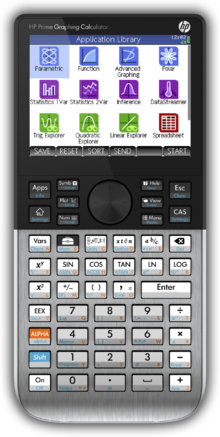HP Prime
The HP Prime is a CAS-capable graphing calculator from HP announced in 2013 and released in September of that year.
It features a 3.5", 16-bit color, multi-touch, TFT screen with a 320x240px resolution.
 The HP Prime calculator | |
| Type | Calculatrice graphique |
|---|---|
| Fabricant | HP |
| Sortie | September 2013 |
| Dernier OS | 2.1.14588 (04/2021) |
| Général | |
| Type d'entrée | RPN, Textbook, Infix |
| Précision | 12 |
| CPU | |
| Processeur | ARM9 (Samsung S3C2416) |
| Fréquence | 400 MHz Max |
| Programmation | |
| Langage(s) de programmation | "HP-Basic" (HPPL), Python |
| Mémoire RAM | 32 MB |
| Mémoire Flash-ROM | 256 MB |
| Interfaces | |
| Connection | Micro-USB |
| Autre | |
| Source d'énergie | Li-Ion Rechargeable battery |
| Poids | 228g |
| Dimensions | 182 x 85.8 x 139 mm |
| Coût | ~150€ |
Software side
Features
- 4 Solver Apps for solving specific types of problems (triangles, finance, linear systems) and a general solver for equations and non-linear systems
- 4 Statistics Apps for descriptive and inferential statistics and data collection
- 4 graphing apps to explore graphs and tables of values
- 3 Explorer Apps for investigating the relationship between the parameters of a function and the shape of the function’s graph
In addition to these apps, there are four more apps of particular interest:
- The Advanced Graphing App allows you to plot and explore the graphs of functions and relations in x and y, including implicit relations, inequalities, and conic sections
- The Geometry App gives you the features of a dynamic geometry application, but with a Symbolic view for defining geometric objects exactly using the CAS
- The Spreadsheet App in which the CAS engine works.
- The Data Streamer app lets you collect data from sensors
The CAS is based on the open-source XCas engine, a powerful and advanced one, made to operate more like Maple, MATLAB, Mathematica, as opposed to something like the TI-Nspire's CAS, which is made to be "easy"[1] and more direcly intuitive for students.
Commands
The HP Prime has 3 classes of commands: HOME, CAS, and Spreadsheet.
Linking Protocol
Firmware files
OS version history
- Pre-releases versions (from leak(s) and testers) : from revision 3xxx to before 5106
- Public release versions: 5106 (2013/08/13), 5447 (2013/11/25), 6030 (2014/03/31, published in May 2014), 6031 (2014/07/02, published in Aug. 2014), 6975 (2014/12/03), 8151 (2015/06/17)
File format
Modifications
- In early November 2013, critor successfully transferred a modified official firmware image to his calculator: First HP Prime firmware patch;
- In early July 2014, Lionel Debroux spent several hours making a "crappy" (his word) PoC for a full-custom third-party armfir.elf, which displays three colored areas on the screen and enters an infinite loop: First third-party firmware and assembly on the Prime.
Hardware Side
For the initial versions:
Components
These have been found on the DVT prototype models[2]. Production models may have different components.
- Screen: Multi-Touch Color Display 3.5" diagonal with a resolution of 320x240px
- Processor (U101): Samsung S3C2416XH-40 - ARM9 (core: ARM926EJ-S) clocked at 400 MHz maximum.
- RAM Memory (U200): Hynix H5MS2562NFR - 32 MB
- Flash Memory (U201): Samsung K9F2G08U0C-SCB0 - 256 MB
- Battery: Li-Ion 3.7V, 1500 mAh (5.55Wh)
Revisions
- Early / First (known) revisions (prototype):
- The calculator was named "HP Advanced Graphing Calculator"
- The back color is white
- The D-Pad was silver-colored
- DVT Prototypes:
- The calculator gets the name "HP Prime Graphing Calculator"
- The D-Pad gets black-colored
- Production models, revision A :
- The calculator gets its back color changed to black.
- Production models, revision C :
- Unlike revision A calculators, this revision is supposed to be able to use the wireless adapters.
Modifications
- Battery: The stock 1500 mAh battery can be replaced by a standard 2200 mAh Samsung Galaxy S3 one, providing a ~50% better capacity.
Programming
About half of the RAM (~ 16MB) is taken up by the OS, the other half is free.[1]
HP-Basic
- Very compatible with the HP 39Gii's BASIC. (mostly additions and fixes)
- Lists are array pointers.[1]
- Objects work through reference counters. You can have a single object reference in many places - it could be hardcoded in the main memory, or a user object on the home screen, or a variable.[1]
- All characters are UTF16.[1]
- Once exported, functions act like they are built in.
- The advanced grapher uses interval based math, and cannot be mixed with user functions.[1]
Native code
No native code (C/ASM...) programming capabilities are offered by default.
Emulation
HP provides a free Windows version of the HP-Prime software.
No actual emulator (official or third-party) has yet been created.
Reviews
- By TI-Planet.org - French and English : PC Software review - Hands-on review - Hardware review
- By hpgraphingcalc.org - Chris Olley - English : https://www.themathszone.com/?p=480
- By "compsystems" - Spanish : (invalid link nowadays)
- By Cemetech - "Christopher Mitchell" - English : https://www.cemetech.net/news.php?id=623
On the market
The HP Prime is mostly sold online, on multiple specialized and general shops. See here for a list of resellers.
References
- ↑ Revenir plus haut en : 1,0 1,1 1,2 1,3 1,4 et 1,5 'tw_hpcalc' (Tim Wessman, HP) - Aug. 08/09, 2013 on Omnimaga's IRC chat
- ↑ Source : https://tiplanet.org/forum/viewtopic.php?f=55&t=12821&lang=en